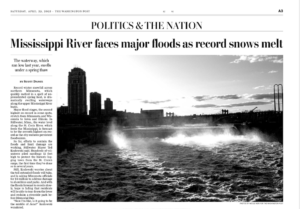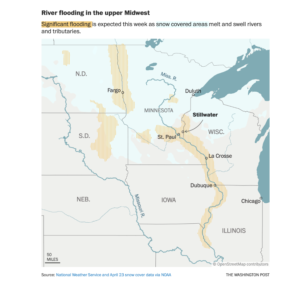Agriculture leaders in the United States House of Representatives are looking to provide at least an additional $10 billion in farmer aid to supplement the recently announced Farmer Bridge Assistance…
Flooding Concerns Along Upper Mississippi River Basin Persist
Scott Dance reported in Saturday’s Washington Post that, “Record winter snowfall across northern Minnesota, which quickly melted in a spell of unprecedented spring heat, is dramatically swelling waterways along the upper Mississippi River basin.

“Major flood stages, the second highest on record in some spots, stretch from Minnesota and Wisconsin to Iowa and Illinois. In Stillwater, Minn., the water level along the St. Croix River, which feeds the Mississippi, is forecast to be the seventh highest on record as the city endures persistent floodwaters.”

Dance explained that, “The floods are the latest boom in what has become a boom-and-bust cycle for the ‘mighty’ Mississippi, which drains 41 percent of the contiguous United States. Last fall, the lower Mississippi diminished to such a trickle that it caused major disruptions in barge traffic. Months before that, heavy rains inundated the central Mississippi Valley with deadly floods.”
“The flooding can cause disruption in river commerce, [Jason Knouft, a professor at Saint Louis University who studies large rivers] said, as the high and fast-moving waters make it harder to move barges upstream.”
The Post article added that, “Flood risks are expected to dissipate as the waters flow southward, because other major tributaries, such as the Ohio and Missouri rivers, are at lower levels, said Bob Criss, a hydrogeologist at Washington University in St. Louis. Farther downstream, the river is expected to reach moderate flood stage in Hannibal, Mo., around the middle of next week, but no flooding is in the forecast for St. Louis or points south.”
Here is the latest forecast crest information for the Mississippi River pic.twitter.com/Q233REXZhd
— NWS Quad Cities (@NWSQuadCities) April 28, 2023
And Wall Street Journal writer Joe Barrett reported in Saturday’s paper that, “Cities in Iowa and Illinois are likely to face a big test of beefed-up flood defenses in the next week as flooding from record snow in Minnesota courses down the Mississippi River.”

Barrett pointed out that, “The floods aren’t expected to cause as much damage as they did in 2019, when melting snow, combined with three major rain events in the Mississippi River Valley, helped create one of the biggest and longest-lasting flood seasons on record. Rainfall is expected to stay below normal as the flood makes its way south, helping to limit damage and potentially allowing floodwaters to recede relatively quickly.”
And Des Moines Register writer Tim Webber reported on Saturday that, “Residents along Iowa’s eastern border are once again dealing with a Mississippi River that doesn’t seem to want to stay in its lane, as melting snow and recent heavy rainfall have combined to create the conditions necessary for major flooding.
“According to the National Weather Service, the worst of the flooding — the river’s crest — is forecast to occur over the weekend and into early next week, depending on the location along the river.
Snow melt in the upper Midwest has caused flooding on the Mississippi River. This will produce minor to moderate flooding into May at forecast points from Canton to Grafton. For more detailed information, check out our river forecast page here: https://t.co/TW8Im5ESey pic.twitter.com/rXPY4BxUsc
— NWS St. Louis (@NWSStLouis) April 29, 2023
“In far northeastern Iowa, that crest has already occurred, and the flooding will begin to subside over the next several days. Farther south, the river won’t reach its highest point until Tuesday or Wednesday.”





